5 things to consider when designing an office
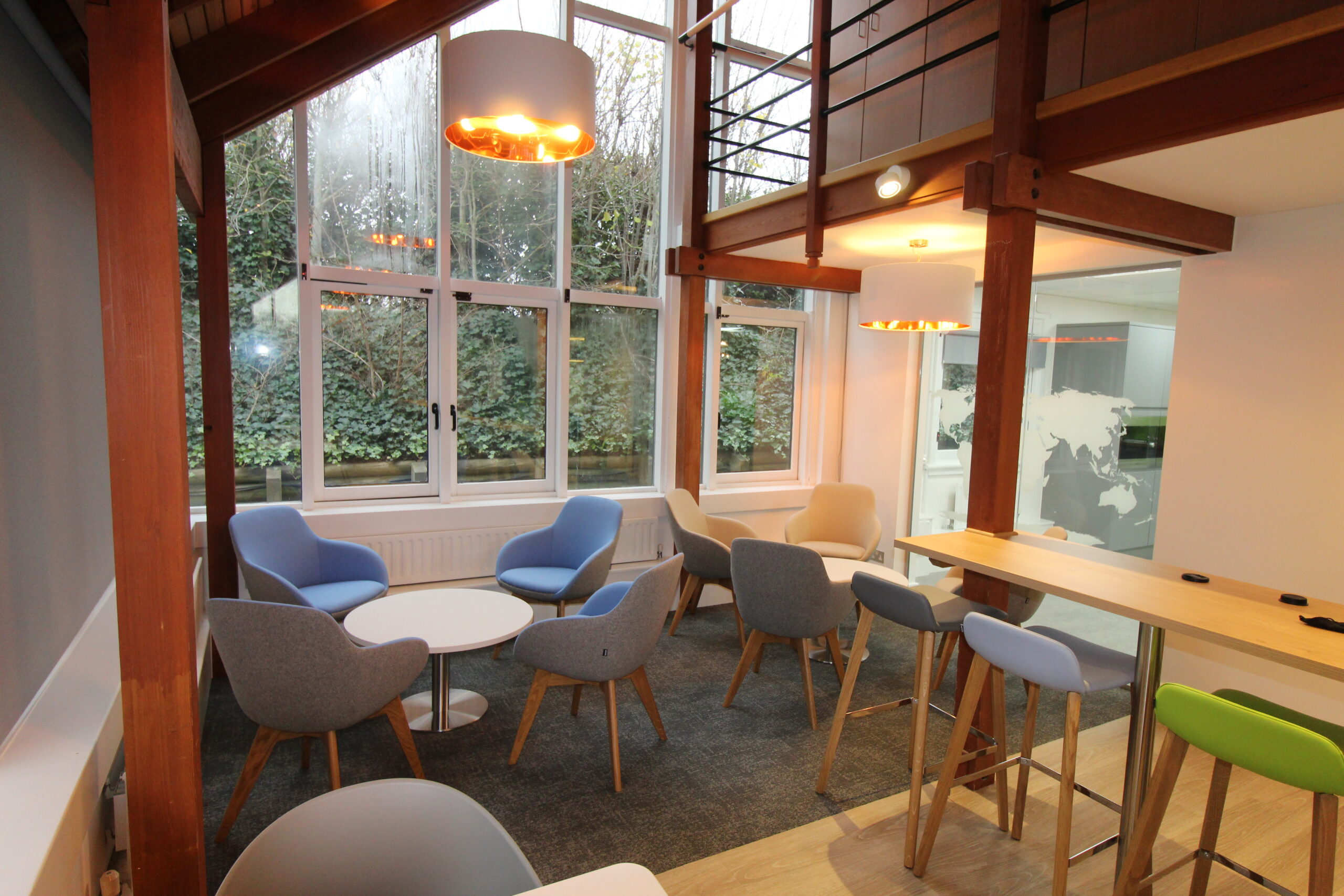
Office design is an investment, and when done right, it can create a collaborative, productive and conducive environment for employees. Wellbeing directly correlates to employee productivity and output, so it pays dividends for employers to invest in a working environment that is inviting and stimulating, as opposed to stark and doldrum.
People spend a large portion of their day at work; with this in mind, as an employer, you want to incite enthusiasm within your employees. A team that has a welcoming space to work is more likely to feel enthused about the workday, and happy employees make for a more productive workforce. Office space design is a key factor that can help you create a workspace that employees love, and are proud of.
Meridian Interiors has been creating modern office spaces for over 20 years, and as experts in office space planning, we are sharing five tips for the perfect office layout below.
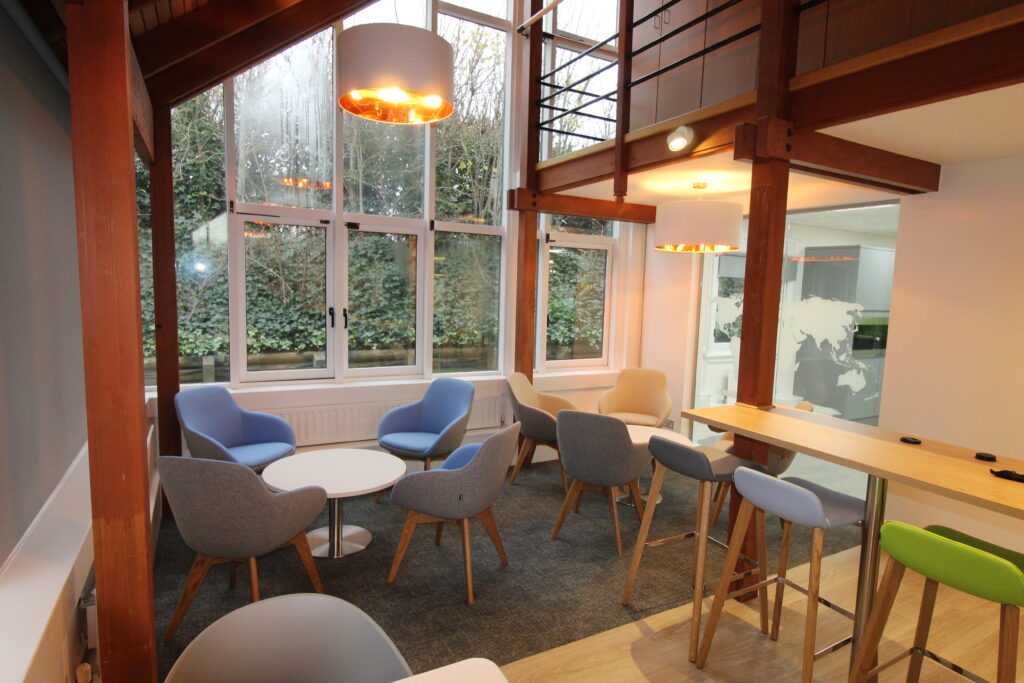
What does your office space need to look like?
Planning ahead
Planning ahead and considering the needs of your employees is key to designing an office space that works for everyone. Think about any specific office design features your team would benefit from. Consider working personalities and working styles: does your team have a lot of group meetings? Would they benefit from multifunctional work areas? It’s worth getting a sense of this before initial plans are drawn up, as the more detailed the brief you are working with, the easier it is for the office design planners to create a space that truly meets the needs of your employees and business from the offset.
Some features your office will benefit from include:
- Breakout spaces
- Glass partitions
- Meeting rooms
- Multifunctional workspaces
- Individual desk space
- Welcoming reception area
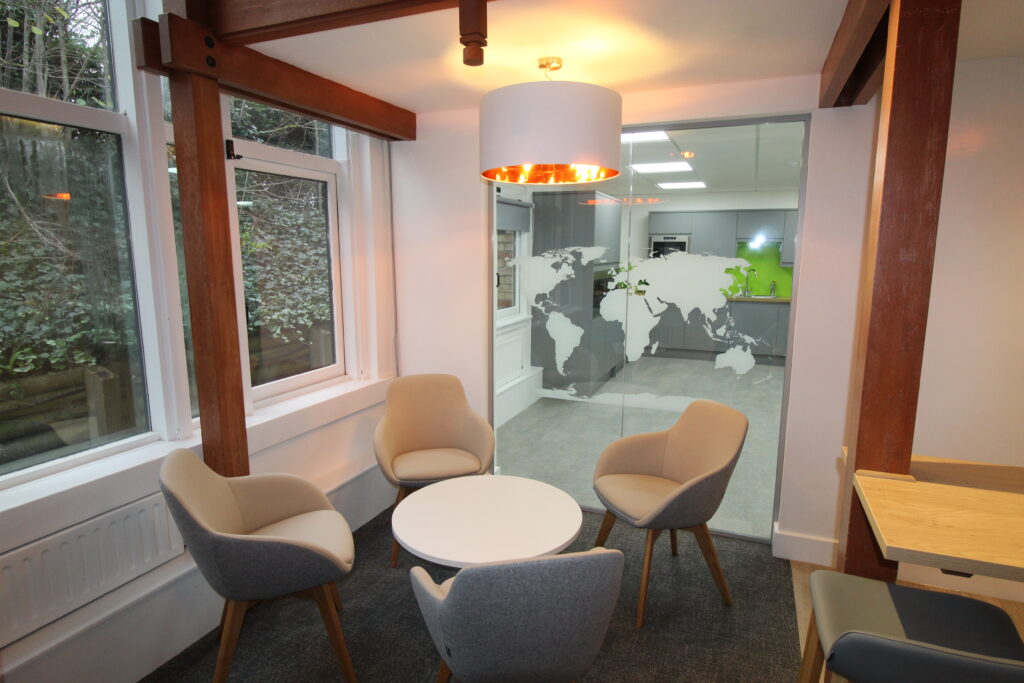
The top 5 things to consider when refurbishing an office space
Below are the top 5 things to focus on when refurbishing an office.
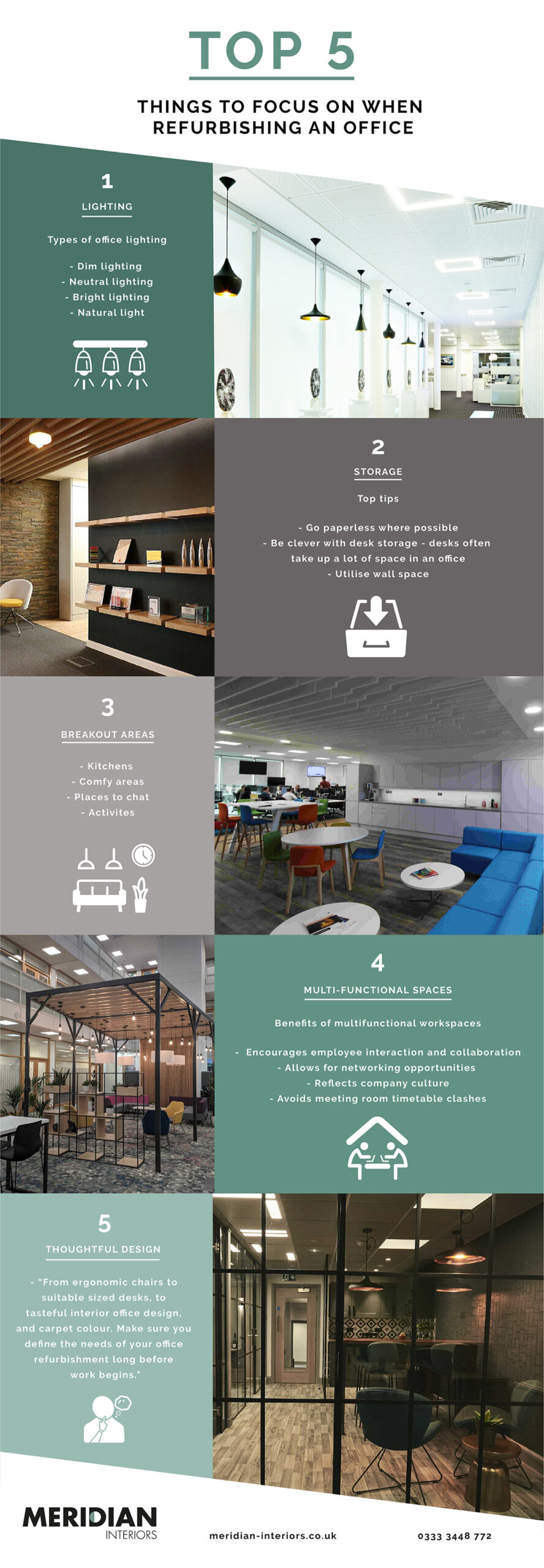
1. Lighting
Office lighting plays an important role in creating a welcoming working space. This is because different tones of lighting evoke different moods. Different styles of artificial lighting will bring a different energy and feel to the office. From high intensity, brighter lighting to dim lighting, the right office lighting can counteract the harsh, stark lighting from the computer screen, and help protect employees’ eyesight.
Types of office lighting and their benefits:
Dim lighting
Dim lighting can help to create a warm and inviting office space, however, be aware of lighting that is too dim, which could slow down productivity in the workplace. It’s important to get the balance right, as you don’t want to evoke an environment that’s too comfortable and leaves employees feeling sleepy. Dim lighting is generally encouraged to help people wind down before sleep, and scientifically speaking, dim light stimulates melatonin production and its resultant drowsiness.
Neutral lighting
Neutral artificial lighting should be welcoming, but with cool undertones to prevent too much of a relaxing setting. Neutral lighting can also help your energy bills from piling up, too. Mid-range colour temperatures will help with alertness, without being too stark. Ideally, neutral lighting with cooler hues should be used in an office setting, with studies finding that higher temperature lighting results in higher workplace productivity.
Bright lighting
Brighter, cooler lighting can help with alertness in the workplace, however, it’s important to avoid stark, unnatural lighting that could cause eye strain and headaches. Brighter lighting lowers melatonin, which reduces fatigue. However, heavily artificial and bright lighting can also ramp up the energy bill, so consider office design that makes use of as much natural light as possible.
Natural light
Natural lighting is very important to consider when designing an office space. Natural lighting helps to feel more productive and can help reduce energy costs, too. Sunlight has a powerful effect on the mental health of employees, helping to boost serotonin and boosting mood. Just as natural light helps you to get up in the morning, it can incentivise employees to feel productive and focused. Sunlight helps us produce Vitamin D and melatonin as well as serotonin, and bright sunlight also helps us feel more alert in general.
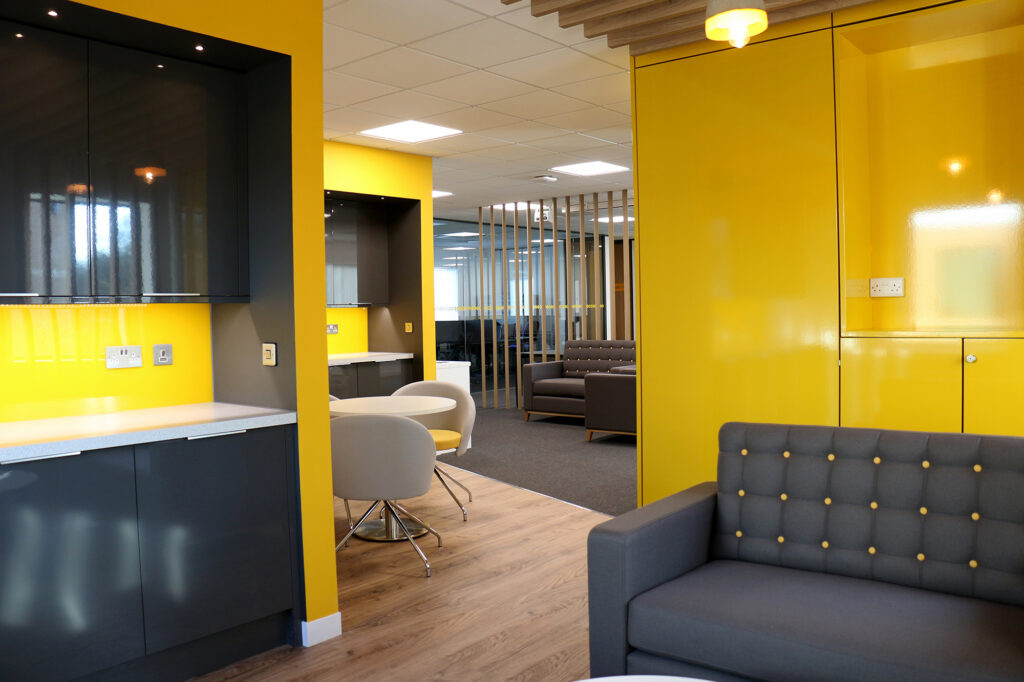
2. Storage
Office storage is another important factor in workplace design. Clever storage can help keep things tidy and organised, especially if you are in a large office. Shelving, drawers, storage walls and cupboards are all office storage ideas that can help you to utilise your space well. You can find office desks with storage, and there are plenty of office space ideas that allow for storage. Good office storage can help to keep any documents and physical data safe, secure and organised. It’s also just good practice to keep on top of clutter in an office; nobody wants to come into work to a mess!
Read our guide for more: How to maximise your office space
- Go paperless where possible – excessive amounts of paper result in more clutter. Of course, there will always be a need for paper within an office environment, but by limiting paper use where possible and going digital, you will save a lot of space and time (and will also help save the planet!)
- Be clever with desk storage – desks often take up a lot of space so where possible utilise the space below and above office desks, with additional drawers or storage units to maximise the office space you’re working with.
- Utilise wall space – wall space is a great way to take up less physical floor area in your office, giving you more room to move around. Shelving and storage walls bring another level to your workspace and can help keep things tidy. Colour-coded filing systems, photo frames and indoor plants are simple ways to smarten up shelves and bring some depth, colour, and personality to your office.
3. Breakout areas
Top tip: Read our blog Office breakout area ideas
Breakout areas are another key part of any office space. Depending on your office location or size, you will need to accommodate a space for employees to relax and enjoy their breaks. Office breakout spaces can include kitchens, comfy areas, and places to chat and unwind with other colleagues. Just as it is important to create a productive environment for your team, it’s also important to provide space for employees to relax and unwind. Employees often use these times to chat to colleagues and switch off; taking breaks throughout the day can help with employee focus and helps prevent burnout, so by providing this space for employees, you’ll see the benefits when they return to work, rejuvenated and refreshed.
4. Multifunctional spaces
Collaborative spaces are arguably one of the most important features of a modern office and are vital to consider in the early design stages of your new office layout. When considering collaborative spaces and meeting rooms, try to futureproof, and allow for all potential situations beyond a simple team meeting. If you regularly have visitors to the office, do your larger office spaces account for this? If you are in the process of expanding, do your initial concept designs consider this? It would be nothing short of a waste to lay the groundwork for a beautiful office space, to only find you grow out of it in six months! Multifunctional workspaces are a must-have feature of a modern office.
Benefits of multifunctional workspaces
Encourages employee interaction and collaboration
If employees have no space to meet and discuss ideas, then you may be missing a trick. By creating a work area that has a multifunctional space, employees will be encouraged to break up the day and will feel more comfortable in sharing ideas in a welcoming space, as opposed to in a formal meeting room.
Allows for networking opportunities
Your office space will be more conducive for impromptu meetings and networking sessions if there is a space that is suitable to hold them. This space will be separate from the main working area, meaning groups won’t disturb those who are in focus mode.
Reflects company culture
Employees appreciate it when employers recognise their needs, and as an employer, you’ll be ticking all the right boxes by providing multiple workspaces to work from. This can help break up the monotony of the workday, and if your team regularly works together on projects, then a multifunctional workspace – where teams can work together – will not only be appreciated but necessary.
Avoids meeting room timetable clashes
It can be very frustrating to find yourself needing a place to work together and finding the meeting room booked up. Having a space that can be used as a makeshift meeting room is very handy for such occasions, and is reflective of a typical working day in an office.
5. Thoughtful design
Of course, an underlying premise that runs through every office design and should be a key consideration for every decision made is thoughtful design. From ergonomic chairs to suitable sized desks, to tasteful interior office design. Make sure you define the needs of your office refurbishment long before work begins. This will help you tie in all your ideas together to create a design that, when it comes to fruition, meets all your requirements and beyond. Together these elements will help create a welcoming, inviting office that employees look forward to working in. It really is that simple!
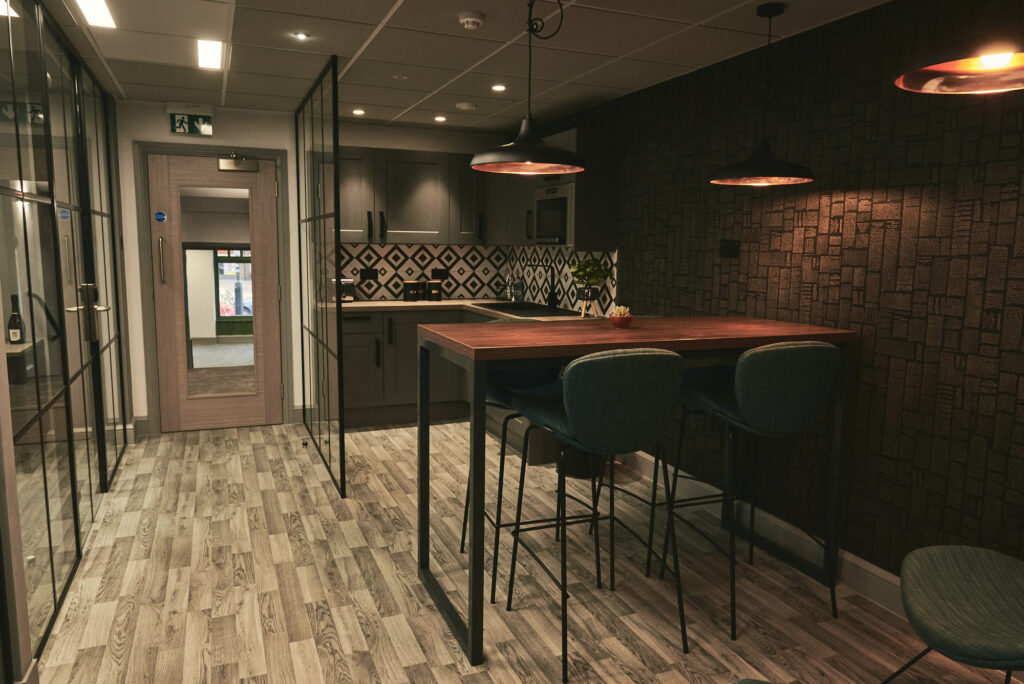
You can find a number of our case studies here, which can help inspire you when coming up with your own office designs.
Check out our blog for more tips and advice:
Office refurbishment guide
How to design a productive office environment
The ultimate guide to office design
Open office vs closed office: A guide
You can speak to our team today to find out more information, or head to our blog for the latest insights.
